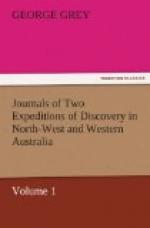In concluding my remarks on the rivers of the north-west I should state that Mr. Stokes, the surveyor of the Beagle, after a careful examination of the coast did not succeed in finding the mouth of the Glenelg; and he imagines that it has several openings, consisting of large mangrove creeks, which fall into Stokes Bay; whilst it is my impression that it will be found to run out somewhere between Camden Sound and Collier’s Bay, and that by some accidental circumstance its mouth was missed. That it joins the sea in a considerable body I should infer from a shoal of porpoises having been seen high up the river, and from the rise and fall of tide, which was twenty feet at the direct distance of thirty miles from the coast.
VALLEYS.
The valleys in this country are of two kinds: those which are almost ravines, bordered on each side by nearly inaccessible cliffs; and valleys of great width, bordered by fertile plains, often extensive, and which occur where the basaltic rocks are developed; although ravines of this formation are also of frequent occurrence in the mountainous parts.
CHARACTER OF THE VALLEYS. SOIL.
The soil found in the valleys of the former kind is extremely rich, but they are all subject to very heavy inundations. As an example of this kind of valley I may cite the one in which we first encamped. Its mean width was only 147 feet, and the rocky precipitous cliffs at half a mile from the sea rose above their base 138 feet. These deep valleys undoubtedly afford water at all seasons of the year.
The sandstone formation is intersected in all directions by valleys of this kind, which are seldom more than from two to three miles apart, while the top of the range between them is a tableland, divided by lateral valleys and gently rising towards the interior. Seawards they all terminate in saltwater creeks, having the same narrow, rocky, and precipitous character as they present themselves.
These tablelands afford good timber, particularly pine. Sheep thrive upon the food there produced, but we found goats did not answer so well.
The richest land in this part of the country is found in the valleys of the second class. The streams flowing through these valleys have generally almost imperceptible currents and often form wide reaches. The land upon their margins is thinly wooded; and I have often seen exposed fine vegetable mould of ten or twelve feet in thickness, through which these streams had worn their way. Good examples of this kind of valley are those through which run the Fitzroy and Glenelg rivers.




